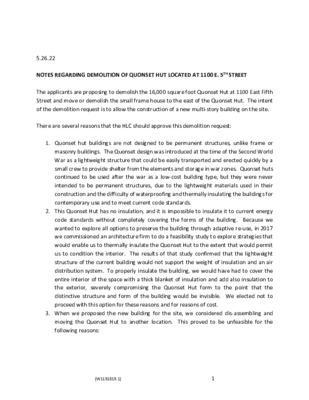D.2.2 - 1100 E. 5th St - Developer letter — original pdf
Backup

5.26.22 NOTES REGARDING DEMOLITION OF QUONSET HUT LOCATED AT 1100 E. 5TH STREET The applicants are proposing to demolish the 16,000 square foot Quonset Hut at 1100 East Fifth Street and move or demolish the small frame house to the east of the Quonset Hut. The intent of the demolition request is to allow the construction of a new multi-story building on the site. There are several reasons that the HLC should approve this demolition request: 1. Quonset hut buildings are not designed to be permanent structures, unlike frame or masonry buildings. The Quonset design was introduced at the time of the Second World War as a lightweight structure that could be easily transported and erected quickly by a small crew to provide shelter from the elements and storage in war zones. Quonset huts continued to be used after the war as a low-cost building type, but they were never intended to be permanent structures, due to the lightweight materials used in their construction and the difficulty of waterproofing and thermally insulating the buildings for contemporary use and to meet current code standards. 2. This Quonset Hut has no insulation, and it is impossible to insulate it to current energy code standards without completely covering the forms of the building. Because we wanted to explore all options to preserve the building through adaptive re-use, in 2017 we commissioned an architecture firm to do a feasibility study to explore strategies that would enable us to thermally insulate the Quonset Hut to the extent that would permit us to condition the interior. The results of that study confirmed that the lightweight structure of the current building would not support the weight of insulation and an air distribution system. To properly insulate the building, we would have had to cover the entire interior of the space with a thick blanket of insulation and add also insulation to the exterior, severely compromising the Quonset Hut form to the point that the distinctive structure and form of the building would be invisible. We elected not to proceed with this option for these reasons and for reasons of cost. 3. When we proposed the new building for the site, we considered dis-assembling and moving the Quonset Hut to another location. This proved to be unfeasible for the following reasons: {W1151819.1} 1 a. We could not find a suitable and affordable vacant site in our market area, which is essentially Central and East Austin. The same factors that have driven appraisals up are also driving up the demand for and the price of building sites. b. We also did a field test to explore the feasibility of disassembling the building. When the building was originally assembled on site, the exterior corrugated panels were attached to the structure with metal screws. In the seventy years since the building was erected, two things have happened that make it unfeasible to take the building apart: i. Most of the thousands of screws have rusted in place, making it impossible to remove them with conventional tools. We found that we would have to drill out every screw to remove them with the potential to damage both the panels and the structure beneath them. ii. Over the decades, numerous layers of paint and caulking (to attempt to stop leaks) have been applied to the entire exterior of the building. There is not feasible way to remove this coating and it hides most of the screws, making them difficult to locate and extract. iii. We attempted to estimate the cost of dis-assembling the building with these constraints and found that the dis-assembly cost far exceeded the cost of purchasing and erecting a new Quonset Hut building of the same size. Thank you, Richard Kooris Manager 11E5 LLC {W1151819.1} 2